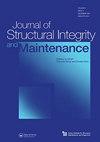用于大跨度混凝土箱梁桥的路桥空载动态称重试验研究
IF 3.1
Q2 ENGINEERING, CIVIL
Journal of Structural Integrity and Maintenance
Pub Date : 2023-04-03
DOI:10.1080/24705314.2023.2165606
引用次数: 0
摘要
摘要道路桥梁动态称重(NOR-BWIM)利用仪器桥梁的响应来识别交通信息的各个方面。该系统避开了传统BWIM系统的许多当前问题,如车道封闭、昂贵的安装等。目前的大多数研究都是短期进行的 或中跨T梁和跨上梁桥。然而,更长的跨度长度、施工方法等会影响NOR-BWIM的功效。因此,有必要在其他桥梁上进一步评估这一技术,如跨度较长的混凝土箱梁桥,以确定NOR-BWIM系统是否仍能在此类桥梁上有效工作。本文对一座大跨度混凝土箱梁桥(144 m跨度)。共对该桥进行了18次实验测试。此外,还开发了一种具有成本效益的传感器,用于类似的大跨度混凝土箱梁桥。已经发现,车轴的数量是可检测的,准确度为100%。此外,轴距、车速和车辆总重的估计平均绝对误差分别为4.6%、2.6%和4.6%。最后,还证明了所开发的具有成本效益的NOR-BWIM系统能够进行车道识别和卡车位置检测。本文章由计算机程序翻译,如有差异,请以英文原文为准。
Nothing-on-road bridge-weigh-in-motion used for long-span, concrete-box-girder bridges: an experimental case study
ABSTRACT Nothing-on-road bridge-weigh-in-motion (NOR-BWIM) leverages the response of an instrumented bridge to identify various aspects of traffic information. This system circumvents many of the current issues with traditional BWIM systems, such as lane closure, expensive installation, etc. Most of the current studies are performed on short or medium-span T-beam and span-on-girder bridges. However, longer span lengths, construction methods, etc. can affect the efficacy of the NOR-BWIM. Thus, there is a need to further evaluate this technique on other bridges such as concrete-box-girder bridges with longer spans, in an effort to ascertain whether or not NOR-BWIM systems would still work effectively on such bridges. This work presents an experimental investigation conducted for a long-span concrete-box-girder bridge (144 m span). A total of 18 experimental tests were performed on the bridge. Moreover, a cost-effective sensor placement was developed for general use on similar long-span concrete-box-girder bridges. It was found that the number of axles is detectable with an accuracy of 100%. Moreover, the estimated mean-absolute-error for axle spacing, vehicle speed, and gross vehicle weight, were 4.6%, 2.6%, and 4.6%, respectively. Finally, it was also demonstrated that the developed cost-effective NOR-BWIM system is capable of lane identification and truck position detection.
求助全文
通过发布文献求助,成功后即可免费获取论文全文。
去求助
来源期刊

Journal of Structural Integrity and Maintenance
ENGINEERING, CIVIL-
CiteScore
3.90
自引率
9.50%
发文量
24
 求助内容:
求助内容: 应助结果提醒方式:
应助结果提醒方式:


